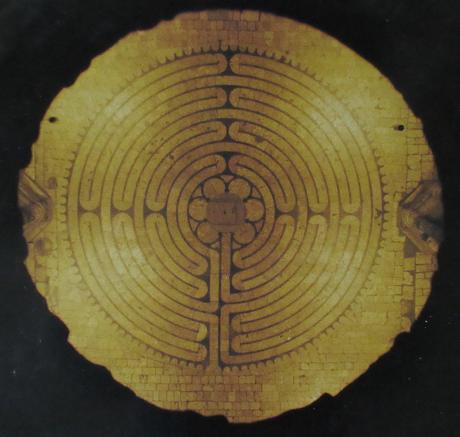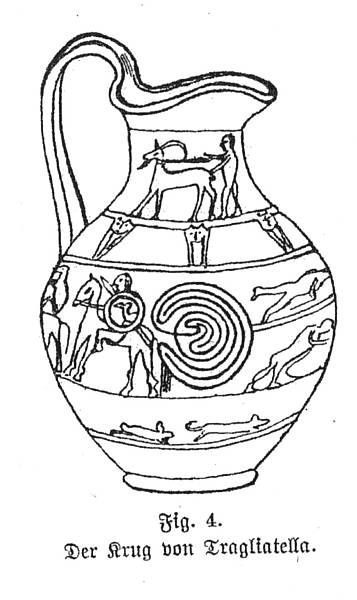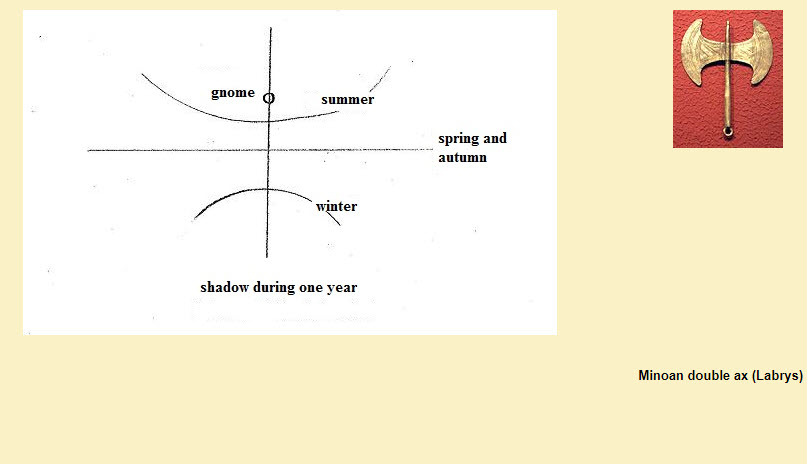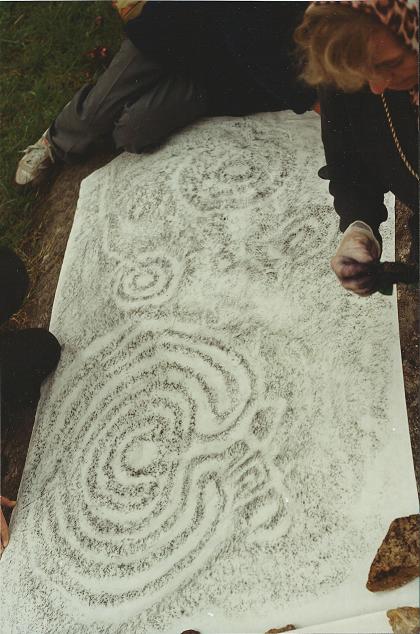Labyrinths – Ritual to Overcome Trepidation
Labyrinths – Ritual to Overcome Trepidation
Berlin · 2017 Uwe Topper topper
Labyrinths – Ritual to overcome trepidation
Inspired by a book by Hermann Kern
1. Trepidation
By “trepidation” ancient astronomers understood a strange variation in the precession-cycle of the Earth, which at certain moments could unexpectedly increase and decrease. Greek and Arab astronomers and mathematicians had stated by measurements that such irregularities sometimes occurred. Their intensive attempts to find an explanation were unsuccessful (as described in detail in my book “Solar Year Cross” Part 3, especially p. 188 ff). The moments at which trepidation was noticed have a common denominator: they occurred after disasters which I have identified as a result of precession jolts. Trepidation can be described as decaying of the earth-movement disturbed by a jolt, measurable as changing length of the tropical year. After the impact, the Earth’s axis describes circles around the precession pole which become smaller after decades, until the original stability (with a new precession rate) is restored.
Although the occurrence of trepidation has been observed after every global catastrophe, it is not taken seriously today because it is no longer observable. To rely on the records of the ancient astronomers is possible but methodically rejected by actualists: Anything that does not happen or could not happen today, could not have happened in the past.
In my book “Solar Year Cross” I have talked about the astronomical evidence of trepidation, and there I gave an explanation for the relatively clear, although chronologically not exactly localizable records. I am suggesting that an age old popular cult: dancing through a labyrinth, might be understood as a ritual to overcome trepidation.
Trepidation, a pendulum-like movement of the Earth which was certainly accompanied by devastation, tsunamis and earthquakes, etc., was probably observable as changing position of the celestial bodies on the horizon which must have disturbed people. And so a ritual was established to ward off the fear

2. Interview with Hermann Kern
I recently learned about an interview which Jürgen von Scheidt made with Hermann Kern on May 27, 1983 (broadcast by Bayr. Rundfunk) discussing his recently published book “Labyrinths. Manifestations and interpretations, 5000 years of presence of a prototype”, 492 pages with 666 illustrations; with scientific apparatus, detailed bibliography, subject index and title register, published in the Prestel publishing house in Munich (in German). It is, so to speak, the ultimate word in research on labyrinths.
From the website of Scheidt on 9/12/2016, I extract some sentences of the interview:
JvSch: “How do you explain that the meaning of the labyrinth has turned into the opposite?”
Dr. Kern: “That’s very difficult to explain. I can only guess about it. The maze was originally a dance movement. The Cretan Labyrinth did not exist as a building, but was a dance floor, on which the trajectories were recorded, so that the dancers could properly perform the steps. This is the so-called Crane Dance, which is described in part by various ancient writers and which in turn probably had a cosmological hermeneutic meaning, in which the movements of stars are depicted in order to ensure by magic the undisturbed sequence of events in the sky. This dance was certainly misleading to outsiders, and it can be demonstrated by individual evidence how over the centuries the understanding of this dance figure is more and more lost, so that only an impression of total confusion remained connected to the maze idea. It is also strange how these two ideas have existed side by side over the millennia and were projected on top of each other. For example, in medieval manuscripts you always find real labyrinths. They open only one way, without the possibility of getting lost. The accompanying text, however, always speaks of the labyrinth in the sense of a maze, that means: in the sense of deadly helpless misguidance. Only now, in the 20th century, has it been realized that these are actually two completely different ideas.”
I understand the answer of Dr. Kern this way (UT): The danger that was experienced in the cosmic event and which led to the crane dance, the “deadly, helpless misguidance”, was to be magically banished. Later, when the danger memory was replaced (by the ‘church’), the dance remained a cult, and then had become meaningless. Above all, it was branded as an aberration, the labyrinth turned into a maze, from which there is no way out (because God’s hand is unchangeable).
Kern emphasizes the importance of the labyrinth symbol as a sign of rebirth, pointing to Sardinia to own the oldest document (in a grave from the 3rd millennium BC).
JvSch: “The figure of the labyrinth is basically very simple. As you describe it, as it appears to be in the most common form, it actually has seven sections. Or how would you express that?”
Dr. Kern: “Seven turns.”
JvSch: “Seven turns on both sides. So, turn means that it always goes from left to right in the pendulum motion and then back again.”
Dr. Kern: “Yes.”
Kern also refers to the seven days of the week because the number of planets as seven is uncertain. He thus emphasizes the calendar relationship, which he also addresses in the book. And with that, my curiosity about this book was aroused.
Labyrinth Cock 1558
Labyrinth vision on an engraving by H. Cock, Antwerp 1558 (Kern S. 331)
3. The book of labyrinths
Friends owned the book and I delved into the approximately 500 pages. In the process, I came across quite astonishing findings that this probably best-informed labyrinth researcher is divulging. He critically discusses (p. 394) a dissertation (Munich 1941) by Waltraut Hunke, who sees in the maiden dances or men’s covenant rites of the labyrinth rituals a “path (the sun spiral?) into the underworld”. Likewise Kern rejects with good reasons “Krause’s wide-ranging speculation about the captivity of the sun virgen in the Labyrinth of the winter dragon”.
Hermann Kern keeps thinking about the real reason for building labyrinths and upholding dances in them, though he finds no easy answer. All that has been written about it does not quite satisfy him. “Obviously the troy-castle tradition was not a learned bauble but a folk lore, originally a sacral affair.” (p. 394)
In Finland (as well as in Greece or anywhere else in the world) the names of labyrinths can only be interpreted as “helplessness of future descendants towards misunderstood relics of earlier times”. (p. 395)
Kern asks (p. 30 f) how far one is entitled to see in the path through the labyrinth the imitation of the movements of celestial bodies. “The labyrinth dance of the Cretan hostages was early interpreted as a ‘gesture dance’, and indeed it is quite tempting, to see that the seven hostages, by doubling (boys and girls) underlined in their importance, in relation to the seven turns of the classical labyrinth of Cretan type and the seven planets … ” And he adds (note 72):
“Probably this is one of the main aspects of the labyrinth, which unfortunately has hardly been worked on so far. An interested historian of astronomy should be able to show perspectives that can only be guessed at the moment.”
So, when did he write that? It was in 1982/83. If I had found the book by Kern earlier, I would probably have found my solution earlier; it comes more than 30 years later, yet it coincides in certain points.
4. The new explanation
In addition to the numerous astronomical reports of trepidation, of the swinging of precession or the star sphere after a catastrophe, I found mythical memories of the incident (2016, p. 314 ff):
“I think it is possible that the affected humanity, after having experienced the erratic movementes of the sun, has created an expressive ritual. The multi-faceted, but always reiterating legend of overcoming the dragon in some places is carried out in a troy-castle, which is a built labyrinth. There young men or the whole community committed a ritual on a solstice or other feast days of the solar calendar. From the Baltic Sea area via England to the northern French cathedrals, tours of the castles called ‘Wendelburgen’ were part of the ritual celebrations. They were even taken over into Christianity, performed in gothic cathedrals,

Mosaic on the floor in the Cathedral of Chartres (France)
and playfully exercised as a dance in Rococo gardens. It meant ensuring the sun’s path during the year. The legendary slaying of the dragon, however, is an act of violence that would be superfluous for a normal year’s run, because as every child knows, the sun continues its course every year, even after the solstice. The ritual must have been reminiscent of a terrible event, of an extraordinary intervention by heavenly powers. Thus reads the interpretation of mythologists, especially Ernst Krause.

Fig. The jug of Tragliatella (after Krause 1893)
And now comes the extraordinary meaning these troy-castles display which was not evaluated by the interpreters of the sagas. Ernst Krause, Willy Pastor, Herman Wirth, Hirsch or Hamkens, who discuss these customs in detail, have only given “crazy, absurd” explanations on this point (Hirsch p. 91). The labyrinth does not depict the normally increasing and then decreasing course of the sun during the year (which symbolically was represented as a spiral). Entering the troy-castle one goes straight forward, then has to turn back and go backwards parallel, then turn back again, and so on, back and forth, the innermost space comes closer and then is further away, the ways getting shorter and longer. After having reached the innermost center one has to turn as well and return in the same way, with unequally growing and dwindling paths, always going back and forth unto the exit (as while dancing the Polonaise, says Hirsch p. 80). The dancers movement looks like a pendulum swinging between many turning points, running to and fro. This movement does not correspond to the usual annual course of the sun. Although the circles of the sun are getting smaller down to the smallest possible at Christmas and then grow again to the largest at St. John’s Day, yet they remain circles with continuous growth or shrinkage; in the standardized pictorial language of myths, the year is a spiral, not a labyrinth.
From the customs and legends in connection with the troy-castles it is clear that a sacrifice must take place, that through a terrible action the heavenly order should be reconciled again. Only in this way do rituals arise. And since the details of these ancient rites are very well received, the pendulum dance as a reflection of the erratic course of the sun must go back to a model such as the trepidation. The rites are conclusive, only sometimes we miss the key. I suggest that the swinging of the sun’s course after the catastrophe was observed, causing a frightful reaction among the survivors. They took part in the terrible events and later played the fearsome course of the sun. The shock demanded healing, the labyrinth was often considered a symbol of rebirth. It was especially danced on St. John’s Day, the old turning point of the path of the sun.
The connection with the trepidation is speculation? So are many of our attempts to explain unclear traditions and folk customs.” (end of quotation from Solar Year Cross)
https://s2.uupload.ir/files/labyrinth_seb_münster_vgnu.jpg
Labyrinth Seb MünsterScheme of the Cretan Labyrinth (in: Sebastian Münster 1628)
In Hermann Kern I learn now multiple confirmation of these thoughts in his somewhat labyrinthine but comprehensive work “Labyrinth”. Besides many authors, he also quotes Krause and Herman Wirth and rejects their unfinished or even false interpretations. Wirth has pointed out the spiraling course of the sun during the year as a protohistoric symbol, but he did not consider that the labyrinth is not depicting a spiral. Even speculation about magic squares and movements of the planet Venus do not convince Kern. He says (page 33):
“So all interpretation wrong? Maybe not. It should be pointed out that there are some facts that do not suggest a solar origin of the labyrinth idea, but suggest that at least in Knossos of the sixth / fourth century BC, solar ideas were associated with the labyrinth. The earliest Knossos coins show a swastika or a swastika meander on their back where later the labyrinth is minted. This also indicates the turning sun wheel like the bull’s head.” (The bull was killed in Crete and declared by Kern to be a sun symbol).
https://s2.uupload.ir/files/labyrinth_münzen_knossos_8unc.jpg
Labyrinth Münzen KnossosCoins from Knossos, today in the Brit. Mus. London (Kern, p. 66)
The connection between the two symbols swastika and labyrinth is corroborated by Kern in mentioning the strange circumstance that on the round Knossian coins both images are rectangular. In any case, the (round) spiral is not one of them, he adds correctly, and concludes this chapter with the paragraph (p. 33):
“As a conclusion to this review, a personal word: The result of these correlation attempts is very unsatisfactory for me because – as at the beginning of my investigation – I still found it obviously difficult to justify the conviction that there must be an essential connex between the labyrinth and the movement of celestial bodies. If this intuitive certainty is not verifiable (so far?), then this may be related to limitations of the analytic instrument, or to the essential characteristic of any living symbol to evade all too clear determinations and reductions. In any case, it remains to hope that such relationship might be clarified by future research.”
In a note he mentions a hitherto unpublished manuscript by D. Alexandrova of Sofia, in which electromagnetic correlations are used to explain the labyrinth, as a cosmogonic model of physical processes that occurred in a distant past on Earth with extraterrestrial origin. But for this Kern (“apart from the dubiousness of the Däniken hypotheses”) sees no clues.
A reader mentioned to me in a letter another predecessor, Herbert Hofer, whose “draft” (typoscript, 1994) may not have been widely read, although in part he continues Kern’s thought, whom he quotes. Hofer speaks (p.20) of the impact of the planetoid Phaeton and of the subsequent settling of the earth as a result of the shifts of water masses. “Therefore, from the annual markings at solstices, spirals and symmetrical-appearing sign patterns had to emerge, reflecting the gyroscopic leveling of the globe into new weight positions.”
He also thinks of spirals, which only indicate the regular course of the sun; the “symmetric appearing pattern” describing the floating would then have to be understood as labyrinth.
Here we are again with my suggestion: It is the temporary discontinuity of the Earth’s movement, which is triggered by a catastrophe and long lasting effects, which has led to the worldwide custom of the labyrinth dance or ritual. Kern also mentions labyrinths in India, Java and Sumatra, as well as in North America (pp. 15 and 21). Throughout Europe, from Iceland to North Africa, he can present a variety of testimonies and brings Bronze Age examples from Spain to the Caucasus.
Their embedding in legends is not completely the same, but mostly heaven-related. The dragon I mentioned as a victim is not a sun symbol (like the Cretan bull) but stands for the cosmic measure of time. Krause (1893,2 p. 14) quotes the expression “liberation of the sun goddess from the bands of the winter demon” which corresponds to my idea, as here a fimbulwinter (post-catastrophic event in the Edda) is meant, not a normal winter.
Yet another aspect of Kern is worth mentioning: in or beside the churches, dances took place in connection with the labyrinth, especially at Easter for the resurrection of Christ, who symbolized salvation. The first dancer picked up a ball and threw it to the others. The ball is the sun, says Kern (p. 214). Later on, the clergy wanted to change or abolish this pagan meaning. The Easter dance explicitly reminded of the darkening of the sun during the crucifixion, which points to a cosmic catastrophe (explained in Topper 2003, chapter 14).
Kern assumes that the two elements, labyrinth and Easter dance, have been brought together from different strands of myth. The dance in the labyrinth has pagan-Norman roots, and the labyrinths in the cathedrals are found mainly in northeastern France, the former Norman territory, as well as lawn labyrinths in England, and as stone figures on the barren ground in Scandinavia (combined also in northern Germany, Krause 1893,1, Chapter 3). In England writers such as Chaucer and Shakespeare associated the maze with the morris-dance in open air. The “mill” was an image of the sky (see below). The Scandinavian labyrinths were often called troy-castle (Trojaburg or Trelleborg, in Wales Caer Droia, and the like), which is likely to come from “turning”, also in the sense of deception. A connection to the Homeric Troy was later established, as Kern emphasizes.
Could the name “Labyrinth” give us a hint to its original meaning? Kern has tried in several ways. That the word “labrys”, the Cretan double ax, could be the origin, has proved untenable, he says (p. 46 f). It was also called (according to Plutarch in the “Moralia”) pelekys, which to me sounds directly connected to Beil (hatched, ax), and thus the deeper context is blurred. There is a sensible path from the double ax to the labyrinth, which was ignored so far: both depict the course of the sun. If I record the path of the shadow of a calendar gnome on a flat area, eg a threshing floor, (as described in “Solar Year Cross” chapter I, 1) we basically get two boundary lines, namely those of the extreme summer movement as a curve around the foot of the gnome, and on the other hand, at the far end, the outward curve of the winter shadow. Between the two, I can draw a straight line as the axis of symmetry, the path of the shadow on the two equinoxial days in spring and autumn.

Minoan double ax (Labrys)
Adding the midday line (vertical) gives the image of a double ax. Such correspondences of image and meaning were welcome to the Bronze Age people who invented writing. They resorted to these “coincidences” and normalized them. Another such example? With pleasure, there are hundreds, because the Greeks, in their inability to understand the former civilization or language almost extinguished before them, created a myriad of interpretations, which can often be described as distortions. In this form they have survived the times and give us riddles.
Kern mentions crane elegance in the quoted interview, the term he often used in his book. It’s the labyrinthine dance on Crete and Delos (p.31), called geranos. One may think of the courtship rituals of the cranes, of their elegant posture, which looks quite human. What do the Persians say when a young man dances gracefully? Ghurnuq, crane! In classical Arabic the word is gharaniq which almost sounds like crane. Minutely, Kern (p. 51 f) shows that the crane dance form described by Homer represents a true labyrinth form, with forward and counter-motion, interlocking, forming a chain that has even been strengthened by a rope (the thread of Ariadne? asks Kern). Where is the connection with the cranes (apart from the funny comparison of their movement)? It resides in the word itself.
In all Germanic languages from Old Norse and Gothic to Old High German and Anglo-Saxon etc., quern or kirn or something similar is the basic word for mill. English “to grind” means grinding, turning, for example turning the lyre, also crank). The mill stands for the mercilessly turning universe, for example in the Edda, but also in many other texts (see Santillana-Dechend, already in the title of their book). The word cart also belongs to it, it rolls because the wheels are turning, and also the year (English year is related to gear, engine). Crown and grain are round. And in Arabic, qorn is the age of the world, a period.
This fits the crane? Yes, the pun is sufficient. In Berber (Tashelheit) the word qirn applies only to the morris game, in which the cosmic context is recognizable. It is not a derivation (etymology) but an unison, which led to the association, which is then understood as a symbol.
Twice seven youths and girls dance into the Knossian Labyrinth, the perfect number of time: 14.
Symbols are limited in their meaning: spirals and concentric circles, as they occur on countless rock art, from Ireland to Spanish Galicia and the Canary Islands, to not coincide with the labyrinth. They have something to do with the course of the sun, they are images of the year and the cosmic laws, but they do not imply the expression of this terrible fear of the unpredictable sun, which embodies the real labyrinth. Nevertheless, there are exceptions: In Mogor (Spanish Galicia) Renate v. Lamezan discovered among other symbols a labyrinth engraved in a rock (Fig.).

Rock engraving at Mogor (Spain)
Documentation by Renate v. Lamezan
Completely inadequate, on the other hand, are comparisons with underground “labyrinths”, as Kern explains. They denote the opposite of this cultic concept. There is a quarry on Crete, the Gortyna Cave, whose plan actually looks confused; cumbersome by detours you arrive to the individual rooms. I found a similar structure in Melilla, where there is an immense tangle of passageways and spaces beneath the age-old city, that is still in use today. And similar courses and “labyrinths” are found worldwide (see Kusch) – only: they are not quite labyrinths in the true sense of the word. Maybe they served for survival, but their attachment is not cultish. On a plan they appear disordered, because the three-dimensional unfolding, the higher or lower position of the corridors, is not recognizable. The real labyrinth always contains the certainty that the way leads out again.
Uwe Topper, Berlin, February 2017; transl. spring 2019
References
Hofer, Herbert G. (1994): Höhlen als frühe Oberservatorien. Die Entschlüsselung des Labyrinths (Stuttgart), draft
Kern, Hermann (1982): Labyrinthe, Erscheinungsformen und Deutungen (Prestel, München; 2° 1983)
Kluge, Friedrich, u. Götze, Alfred (1881): Etymologisches Wörterbuch der deutschen Sprache (14. Aufl. Berlin 1948)
Krause, Ernst (1893, 1): Die Trojaburgen Nordeuropas (Leipzig; reprint Osnabrück 1981) – (1893, 2): Die nordische Herkunft der Trojasage (reprint 2007)
Kusch, Heinrich und Ingrid (2011): Tore zur Unterwelt (Graz)
Münster, Sebastian (1628): Cosmographia (Bd. 2, Basel, reprint 2010)
Santillana, G. de/ Dechend, H. v. (1969): Hamlet’s Mill (Boston)
Scheidt, Jürgen vom (1983): Hermann Kern: Interview mit dem Labyrinth-Forscher (am 21. 1. 2013 erneut ins Internet gestellt)
Topper, Uwe (2003): Zeitfälschung (Herbig, München)
(2016): Das Jahrkreuz (Solar Year Cross, Tübingen)







